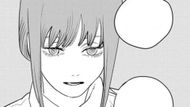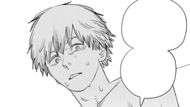Chainsaw Man is an invitation to a dark and visceral world where Devils are the products of the fears of humanity. Our protagonist, Denji, and the Chainsaw Devil Pochita become a hybrid fighter called Chainsaw Man. Among such repeated motifs that puzzled and fascinated viewers is the locked door that Denji sees in her dreams, so much so that it became a central enigma of the show. The action-filled confrontations that make up most of Chainsaw Man are impressive, but it is this door in the subconscious that shows the trauma that Denji is going through.
The door in the dream of Denji in Chainsaw Man is a repressed memory of what happened to him as a child. According to the memory, it was not his father who killed himself, but that he killed his father in self-defence. Years of evading it led Denji to open this door in chapter 82 of the manga and face the truth about his past that he had tried to forget.

Throughout most of Chainsaw Man, the audience can see Denji sleeping and hear Pochita tell her, “...don’t open the door, and the ghostly figure of the door is alone in an alley or in his fantasy world. The first instance of the door appears in Denji's childhood memory dream sequences, where the door is covered with sticky notes and located in a dark alley, typically immediately after the mention of his father's death. The door turns out to be a psychological barrier as well as a narrative hint to hidden violence and suppressed guilt.
The door becomes symbolic as Chainsaw Man advances. The manga also reveals that Denji killed his father, but the Yakuza concealed the death as a suicide, and Denji had to take on his father's debt. The door, therefore, acts as a psychological lock Denji sets up to keep away the thought of his contribution to the trauma and the shame of the memory itself. It is when Makima finally convinces Denji to open the door that causes a collapse of his emotional defences and manipulation by the Control Devil.
Chainsaw Man - Behind the Door and Its Narrative Significance
When Denji eventually opens the door in his dream world in Chainsaw Man, the scene connects directly to the killing of his friends and his own downfall. Makima takes this chance to dominate Denji by revealing his guilt and vulnerability. The discovery of what is behind the door is also associated with the loss of innocence and the emergence of Chainsaw Man, i.e., the moment when his human normal life ceases to exist and his identity as a devil-hunter takes full effect.
The door motif also connects to greater themes of identity, trauma, and humanity in Chainsaw Man. The fact that Denji does not want to open it is an indicator of his fear of himself, and the fact that Pochita advises Denji against doing so suggests that even devils have a protective instinct. The story integrates psychological horror with action through the door, driving the point that Denji fights internal battles the most.

Lastly, the door is a marker of the transition between Part 1 and Part 2 of Chainsaw Man. As Denji attends high school and the narrative shifts to the War Devil Yoru and further apocalyptic conflicts, the door opening marks a turning point: Denji is no longer able to escape his past, and the scenery of his struggle changes. Although the specific imagery behind the door is not a distinct episode in the anime as of now, the revelation in the manga is extensively written about, and it defines any further events.
To sum up, the locked door in tDenji's dream in Chainsaw Man is much more than a repetitive visual; it is the key to his darkest secret and the gate to his enlightenment. What stands behind it is the reality of the death of his father, his guilt, and his lost innocence. The meaning of the door continues to be important in the series, as viewers are reminded that, to Denji, the toughest battle was internal.
